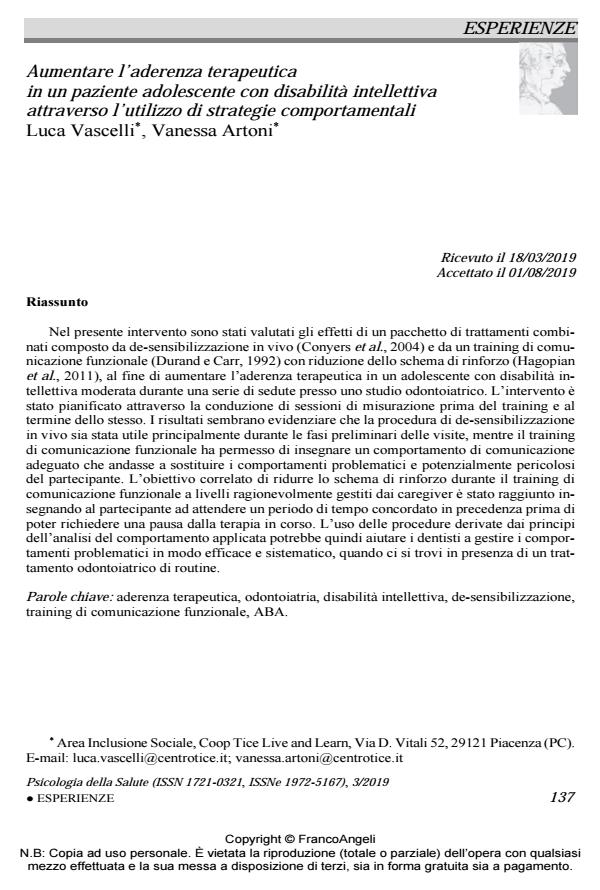Aumentare l’aderenza terapeutica in un paziente adolescente con disabilità intellettiva attraverso l’utilizzo di strategie comportamentali
Titolo Rivista PSICOLOGIA DELLA SALUTE
Autori/Curatori Luca Vascelli, Vanessa Artoni
Anno di pubblicazione 2019 Fascicolo 2019/3
Lingua Italiano Numero pagine 17 P. 137-153 Dimensione file 221 KB
DOI 10.3280/PDS2019-003008
Il DOI è il codice a barre della proprietà intellettuale: per saperne di più
clicca qui
Qui sotto puoi vedere in anteprima la prima pagina di questo articolo.
Se questo articolo ti interessa, lo puoi acquistare (e scaricare in formato pdf) seguendo le facili indicazioni per acquistare il download credit. Acquista Download Credits per scaricare questo Articolo in formato PDF

FrancoAngeli è membro della Publishers International Linking Association, Inc (PILA)associazione indipendente e non profit per facilitare (attraverso i servizi tecnologici implementati da CrossRef.org) l’accesso degli studiosi ai contenuti digitali nelle pubblicazioni professionali e scientifiche
Nel presente intervento sono stati valutati gli effetti di un pacchetto di trattamenti combinati composto da de-sensibilizzazione in vivo (Conyers et al., 2004) e da un training di comunicazione funzionale (Durand e Carr, 1992) con riduzione dello schema di rinforzo (Hagopian et al., 2011), al fine di aumentare l’aderenza terapeutica in un adolescente con disabilità intellettiva moderata durante una serie di sedute presso uno studio odontoiatrico. L’intervento è stato pianificato attraverso la conduzione di sessioni di misurazione prima del training e al termine dello stesso. I risultati sembrano evidenziare che la procedura di de-sensibilizzazione in vivo sia stata utile principalmente durante le fasi preliminari delle visite, mentre il training di comunicazione funzionale ha permesso di insegnare un comportamento di comunicazione adeguato che andasse a sostituire i comportamenti problematici e potenzialmente pericolosi del partecipante. L’obiettivo correlato di ridurre lo schema di rinforzo durante il training di comunicazione funzionale a livelli ragionevolmente gestiti dai caregiver è stato raggiunto insegnando al partecipante ad attendere un periodo di tempo concordato in precedenza prima di poter richiedere una pausa dalla terapia in corso. L’uso delle procedure derivate dai principi dell’analisi del comportamento applicata potrebbe quindi aiutare i dentisti a gestire i comportamenti problematici in modo efficace e sistematico, quando ci si trovi in presenza di un trattamento odontoiatrico di routine.
Parole chiave:Aderenza terapeutica, odontoiatria, disabilità intellettiva, de-sensibilizzazione, training di comunicazione funzionale, ABA
Luca Vascelli, Vanessa Artoni, Aumentare l’aderenza terapeutica in un paziente adolescente con disabilità intellettiva attraverso l’utilizzo di strategie comportamentali in "PSICOLOGIA DELLA SALUTE" 3/2019, pp 137-153, DOI: 10.3280/PDS2019-003008